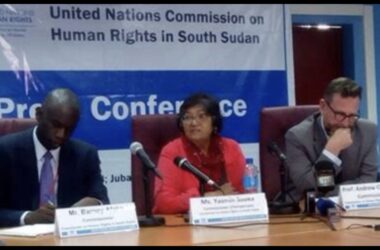By Philip Buda Ladu
A devastating confluence of conflict, climate change, and entrenched poverty has driven 2.3 million children in South Sudan to acute, life-threatening malnutrition.
This dire warning comes from Save the Children, noting that these soaring rates have emerged just months after foreign governments significantly cut funding to some of the world’s most vulnerable nations, the children’s organization echoed in a statement extended to this outlet.
Latest figures from the Integrated Phase Classification (IPC), the global authority on hunger severity, paint a grim picture.
In just over six months, the number of people experiencing the most severe level of acute hunger (IPC Phase 5) in South Sudan has shockingly doubled to 83,000 from 41,000.
Furthermore, the percentage of the population living in crisis levels of acute hunger (IPC Phase 3 and above) has surged by 21%, from 47% to 57%.
This deepening crisis is reflected in the escalating numbers of acutely malnourished children. A scarcity of food, insufficient medical supplies in health facilities, and major disease outbreaks, including cholera, have contributed to a 10.5% increase in acutely malnourished children under five, rising from 2.1 million to 2.3 million – an additional 218,000 young lives now at severe risk.
Data collected across 80 counties revealed that 62 (78%) recorded a general deterioration in acute malnutrition, according to the IPC.
Children are inherently the most vulnerable during food crises. Without adequate nutrition, they face a high risk of acute malnutrition, which can lead to stunting, impede crucial mental and physical development, and dramatically increase susceptibility to deadly diseases.
This catastrophic scenario is unfolding precisely as foreign aid cuts bring vital, life-saving programmes across South Sudan – one of the world’s most aid-dependent countries – to a devastating standstill.
Chris Nyamandi, Save the Children Country Director in South Sudan, issued a heartfelt plea:
“When there is a lack of food, children’s bodies become a battleground. The impacts of malnutrition – stunting, impeded mental and physical development, and increased risk of contracting deadly diseases – can be life-shattering. These latest figures are a cry to donors: please, see what happens to children when you let humanitarian crises take hold. Please, don’t leave the children of South Sudan behind. This is about survival for today – but it is also about hope for tomorrow, to build a better world.”
Globally, severe acute malnutrition accounts for one in five deaths among children under five, making it a leading threat to child survival. Encouragingly, community-based programmes combining medical treatment and therapeutic foods, such as fortified peanut paste, boast a 90% success rate. However, the efficacy of these programs is now severely jeopardized.
Earlier this year, Save the Children warned that at least 110,000 severely acutely malnourished children supported by the aid agency across 10 countries, including South Sudan, could lose access to life-saving ready-to-use emergency food and nutrition programmes as aid cuts impact supplies in the coming months.
The charity also reported a tragic incident where at least five children with cholera in South Sudan died during arduous journeys to seek medical treatment, a consequence of aid cuts forcing local health services to close amid a major outbreak of the deadly disease.
Save the Children has maintained a presence in South Sudan since 1991, working tirelessly to provide children with access to education, healthcare, and nutritional support, while also assisting families with food security and livelihood assistance.
The organisation reiterates its urgent call for renewed international support to avert a deepening humanitarian catastrophe.



